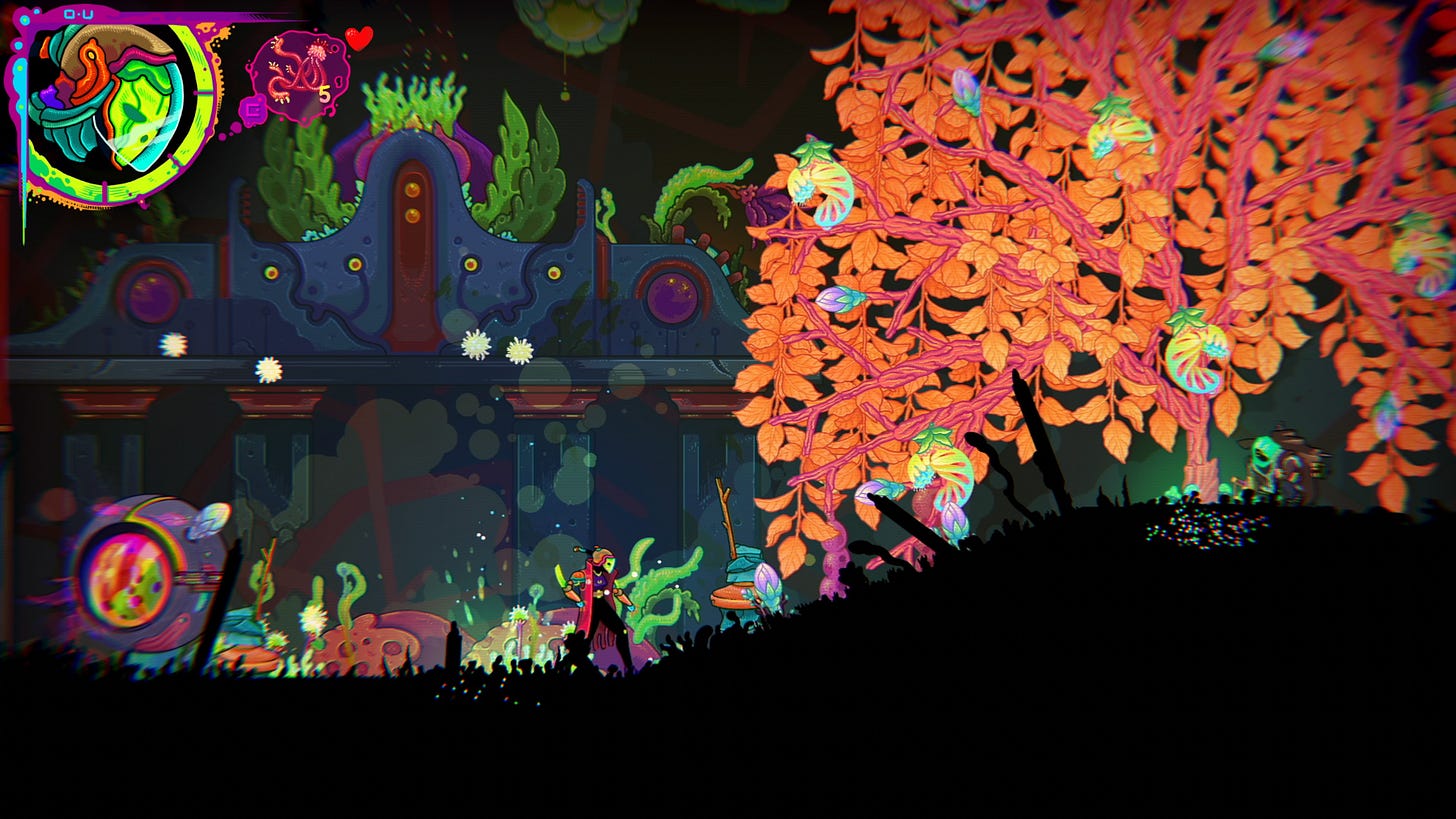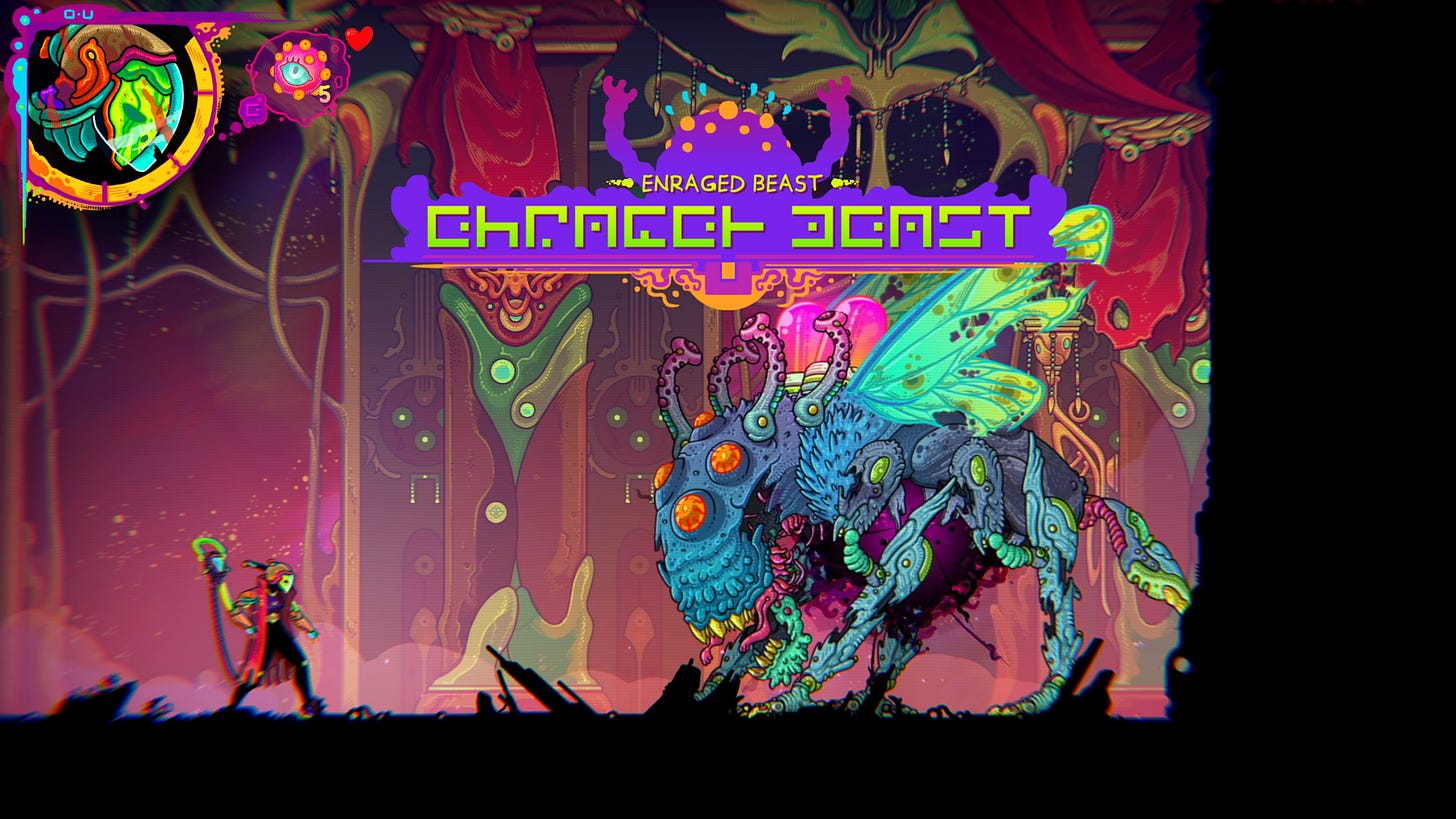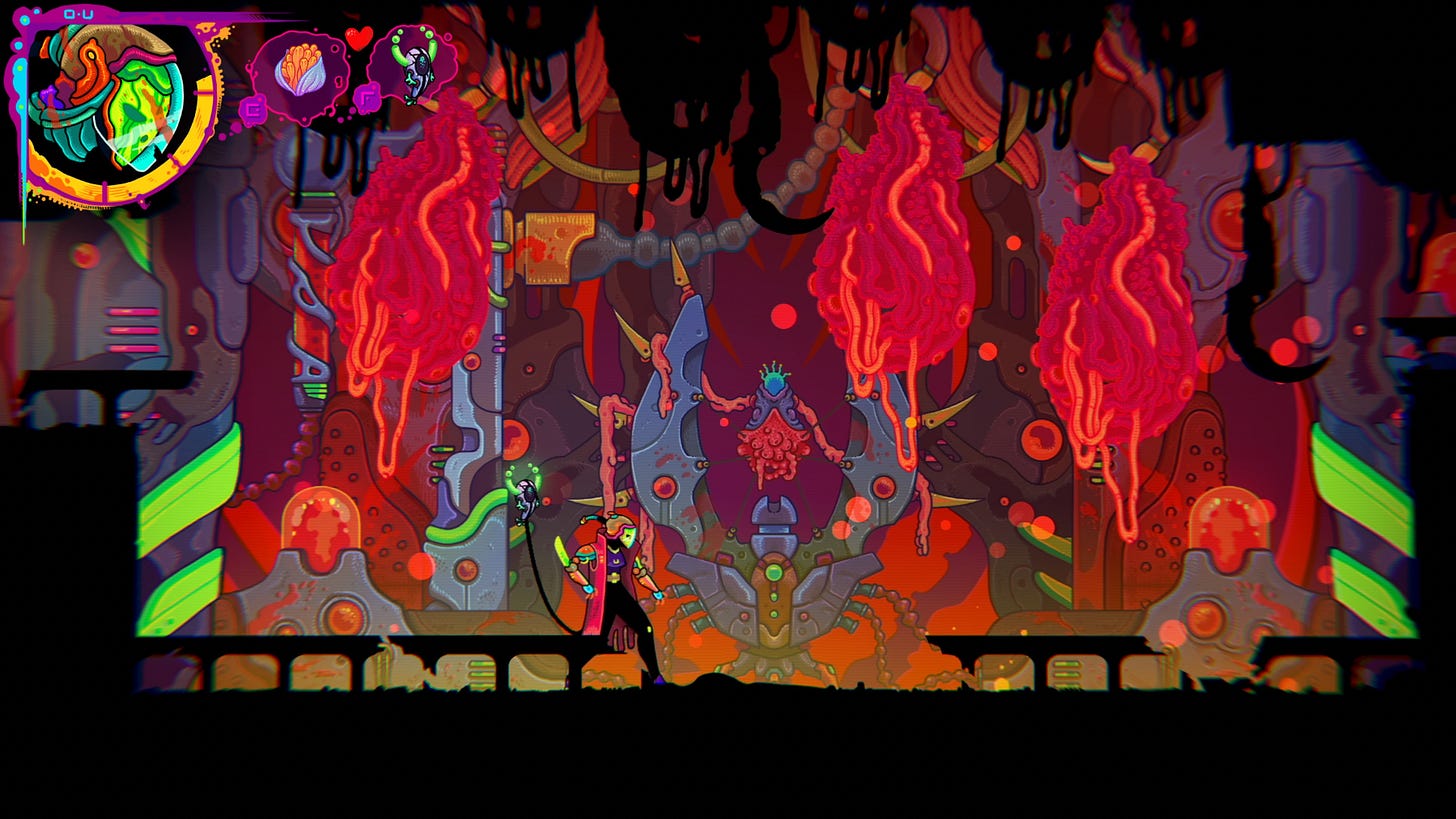In a twist, some video games can end early. Really early.
Plus: An accessibility request, and an astounding new game that mixes Metroidvania with gardening

About two hours into the classic role playing game Golden Sun, an old healer tells the player’s character that the fate of the world rests with them. He asks if they're up to the task.
Most games assume you’ll say yes. They often force that answer.
But Golden Sun, released in 2001 for the Game Boy Advance, is different.
You can say yes and play for another 20+ hours.
Or you can say no and refuse to save the world. “I can’t blame you,” the old man says. “I couldn’t do it if I were in your shoes.” A text bubble appears, saying the world will drift toward its destruction. And the game ends.
Games rarely do this. Sure, you can fail early in most games and hit a Game Over screen, but the number of games that offer a proper finale just minutes after you begin playing them is low—disappointingly so, if this kind of twist delights you.
The re-release of Golden Sun last month on Nintendo Switch got me thinking about games with intentionally early endings and how those endings came to be.
And that got me thinking about Far Cry 4, probably the best-known game for doing this very rare thing.
Released in 2014, Ubisoft’s Far Cry 4 is in many ways your typical big budget first-person shooter. The setting may be distinct: You’re Ajay Gale, a young man who has traveled to the fictional country of Kyrat to return the ashes of his mother, who was once in a love affair with Kyrat’s dictator, Pagan Min. The action is more common: Within the first 20 minutes, you get a gun and then spend the next 20-30 hours shooting Pagan Min’s soldiers.
About two minutes into the game, before you get a gun, Gale is riding a bus and caught in the crossfire between Kyrati rebels and Min’s forces. He is airlifted to Min’s palace, where the suave, sinister dictator sits him in a chair in front of a meal of crab rangoon. Min considers the urn of ashes, sends another man off to be tortured and then leaves the room, asking Gale to wait for his return.
Far Cry 4’s creative director, Alex Hutchinson remembers, reviewing the script for this moment in a windowless meeting room in Ubisoft Montreal, a couple of years before the game’s completion.
He recalls joking with other senior developers on the game about the logic of video game worlds, about how it didn’t matter what the story of Far Cry 4 was supposed to be and didn’t matter what the characters were saying, because the game is ultimately about shooting things.
But, what if players listened to Pagan Min, he remembers saying to his colleagues in that room. “I was like: ‘What if, in the first cinematic, you just listen to him. You pretend he's not a video game character and you didn't really buy [the game] just to shoot everything. What would happen?
“And we were like, ‘Well, he would just help you.’ We were laughing in the meeting, and I was like, ‘Let's do it.’”
Hutchinson hadn’t heard about Golden Sun’s alternate ending and he had no interest in making Far Cry 4’s surprise ending the result of a dialogue choice. Instead, Pagan Min would simply ask Gale to wait.
“No one in the history of video games has waited in the room when asked to wait in the room,” Hutchinson said.
But if the player waited, the alternate ending would trigger.
Min would return to the room, express his surprise and then fly off with you in a chopper to set your mom’s ashes down in a shrine. Game over. Roll credits. The end.
Hutchinson knew it wouldn’t take a lot of work to add the alternate ending. They’d need to write a few extra lines of script and make one new non-interactive scene. “We realized we could probably schedule this, because it's literally one cinematic in locations that we already had,” he said.
Imaginative game designers can often come up with small tweaks and additions that individually won’t derail a project. Commit to too many, though, and the schedule can blow up.
This one, Hutchinson reasoned, was worth doing.
Previous Far Cry games had delivered admirably flexible gameplay. Those games set players loose in big virtual worlds with a range of options for combat: players could use guns or bows, fight enemies up close or from afar, set traps or even shoot the lock off the cage of a wild animal and let the fauna fight it out. For Far Cry 4, he wanted to find ways to make the game’s narrative also feel flexible (one scuttled idea would have allowed players to switch sides in the game’s overall conflict). Steering the game into an ending just 15 minutes after it began fit that mandate.
“I really liked the idea that it would unsettle [players] about the kind of game that they were in,” Hutchinson recalls. “Well, if that happens, what else could happen? Even if we didn't play it up that much, I liked the idea that players would suddenly start to listen to the cutscenes a little bit more.”
The biggest internal debate about Far Cry 4’s surprise early ending, Hutchinson recalls, was how long the player would have to make Gale wait, how long they’d have to sit there before Min returned to trigger the alternate conclusion. It had to be a while, so that players didn’t accidentally initiate it, but if the wait was too long, players might not find it. They went with 15 minutes, which worried some on the team. That fear was moot, because reviewers found it—and wrote about it—before the game even came out. (It might have helped that there was a mysterious “crab rangoon” goal offered via an online Ubisoft service.)
The early ending was a hit. Hutchinson left Ubisoft shortly after Far Cry 4 was released, but its sequels offered variations on the twist. There’s one in 2018’s Far Cry 5 and one early in 2021’s Far Cry 6.
Hutchinson returned to the idea as well, for 2020’s Journey to the Savage Planet, the debut release for his current studio, Raccoon Logic. Players can bail on that adventure early by leaving the titular planet. There’s an achievement for it called Screw This Noise. On Steam its been earned by 2.8% of the game’s PC players.
Extra: Golden Sun and Far Cry 4-6 aren’t alone. Here are two other games with surprise, early endings, both from 2009:
In The Saboteur, players control a race car driver turned freedom fighter who battles the Nazis in occupied France. Players can shoot the game’s main Nazi antagonist during a game-opening car race and skip the rest of the adventure.
In Shadow Complex, players infiltrate an enemy base to rescue the protagonist’s girlfriend. Except, once she is captured in the game’s opening moments, the player can simply run to the left of the screen, triggering a cut scene where the lead character drives away. “Eh, plenty of fish in the sea!” he states, avoiding the entire game while the credits roll.
Item 2: Making accessibility info more accessible

Accessibility information about video games should not be kept secret until close to a game’s release, as is often the practice, according to critic and accessibility consultant Laura Kate Dale.
“Accessibility information is all too often treated as a marketing reveal, something for PR teams to hold onto for an extra dose of promotion in the crucial days leading up to a game finally going on sale,” Dale said during a showcase last week for publisher Whitethorn Games.
“In practice, this means that most of the time, when disabled gamers like myself see a new video game revealed, we’re torn between getting excited for what was shown and holding onto some hesitancy in case the game isn’t going to be playable for us when it releases.”
Video game publishers and developers have introduced a lot of accessibility options to games in recent years. It’s become standard for major games from Xbox, PlayStation, EA, Ubisoft and more to launch with a suite of options that can accommodate players with limited vision or hearing, or other accessibility needs. But such information is often revealed close to a game’s launch.
Dale is trying to change that. Last June, she hosted an “Access-Ability” showcase that included accessibility options for the upcoming games featured. Last week’s Whitethorn showcase, during which Dale spoke, did the same, offering information about planned accessibility features for the publisher’s games, weeks or months ahead of launch.
Item 3: In brief…
🌏 Game designers and climate activists are collaborating on All Rise an early-in-development law game that involves “taking big corporates and others responsible for destroying the planet to court,” one of the project’s leaders, Joost Vervoort, explains
The game’s creators are designing a mix of card battles and Ace Attorney courtroom drama, in the name of environmental justice.
💰 Krafton reported over $578 million in operating profit for 2023, largely on the strength of the Korean publisher’s globally popular battle royale game PUBG and its resumption of availability in India.
The publisher’s financial update was accompanied by promotion for upcoming projects, including Unknown Worlds’ anticipated underwater survival game Subnautica 2. In a sign of how controversial certain game industry terms can be these days, Krafton’s reference to the project as “games-as-a-service” was quickly clarified by Unknown Worlds: true to prior Subnautica games, the sequel will not have a battle pass, season pass or subscription but would be continually updated for years, the developers said. It is not expected to launch into early access until 2025 or later.
💻 Helldivers 2, the first Sony PlayStation-published game to launch on PC at the same time it launched on PlayStation 5, has had more players on PC at launch than any game from Sony, IGN reports. (Sony has said that it plans to release multiplayer/service games on PC and PlayStation at the same time; single-player games will still get a year or more head start on console).
😲 Palworld studio Pocket Pair is “overwhelmingly short of people” and eager to hire developers, especially planners and engineers, according to a studio posting covered by PC Gamer.
💬 SAG-AFTRA has ratified a “Tiered-Budget Independent Interactive Media Agreement,” basically a union-backed contract for voice- and performance-actors for games that have a budget between $250,000 and $15,000,000, a range far higher than the capped $1.5 million of the contract it’s replacing, per The Hollywood Reporter. (This is different than the main contract the union has been negotiating with AAA publishers.)
“No projects have signed on yet, per the union, though [SAG AFTRA national executive director Duncan] Crabtree-Ireland said that developers had previously asked SAG-AFTRA for an agreement of this nature,” according to the THR article.
Item 4: Ultros astounds
I have a new favorite game of the year (so far). It’s Ultros, a vibrant sci-fi action/exploration game for PC and PlayStation from Swedish studio Hadoque
It’s a Metroidvania with gardening. You’re searching hallways, filling out a map, and gaining new abilities to use in a space station full of alien critters. You’re learning about plants that can double as platforms, swinging vines or launch pads. And then you start unlocking tools to plant and nurture those shrubs and trees yourself, transforming the space station’s rooms (and what you can do in them) in the process.
It’s the most screenshot-able game I’ve played in years. Look at this!
And it has the single most elaborate puzzle I’ve ever seen in a game. (I don’t want to spoil it, but in case you find that daunting, rest assured that Ultros’ designers only require you to solve a small part of its mega-puzzle. Doing the whole thing is an alluring, optional challenge).









You're right Ultros is amazing looking!
I'm enjoying the art a lot.
Gameplay and controls are good. Sound design (especially on your weapon is good too).
But I can't believe how much I like all the wacky descriptions and lore. Usually I skip over all that. But the upgrade system is cool and even the double-jump thingy is neat! I like how if you kill something wrong you get "bloody pulp" food which doesn't upgrade you as much.
I played the demo on Steam, but I bought it on PS5 to enjoy as a regular console game on my TV..
Also enjoyed the perfectly logical early-credits from Larian in BG3.